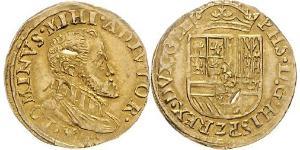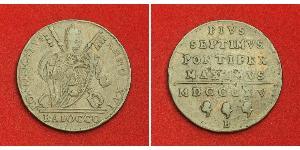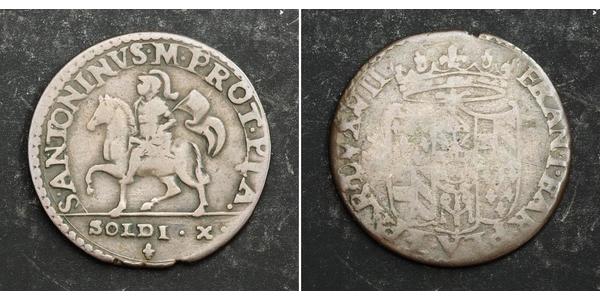(Vendida por $43.0)
Denomination: 10 Soldi Mint Period: 1694-1727 AD Reference: KM-28 ($45 in VF!) Condition: Typical weak reverse, otherwise a nice VF coin! Material: Billon Silver (low grade silver and bronze alloy) Diameter: 24mm Weight: 4.01gm
Obverse: St. Antoninus on horseback left. Value in exergue. Legend: S . ANTONINVS . M . PROT . PLA . Exergue: . SOLDI . X . / (lis)
Reverse: Crowned coat-of-arms. Legend: FRAN . I . FAR . PLA . I . PAR . DVX . VII .
Saint Antoninus of Piacenza, or Placentia (died 303 AD) is a patron saint of Piacenza in Italy. He is venerated as a saint and martyr in the Roman Catholic Church, with a feast day of 30 September. He is not to be confused with the six century pilgrim, his townsman Antoninus of Piacenza (pilgrim). The saint was said to have been martyred at Piacenza or Travo, in the 303 AD Diocletianic Persecution. He appears in Victricius' De Laude Sanctorum of the same century, and the somewhat later Martyrologium Hieronymianum. Sabinus of Piacenza established his sanctuary, following a rediscovery of the relics. A later tradition made him a member of the legendary Theban Legion. Piacenza's Basilica di Sant'Antonino bears his name.
Francesco Farnese (19 May 1678 – 26 February 1727) reigned as the seventh and penultimate Farnese Duke of Parma and Piacenza from 1694 until his death. Married to Dorothea Sophia of the Palatinate, his brother Odoardo's widow, to avoid the return of her dowry, Francesco curtailed court expenditure, enormous under his father and predecessor, Ranuccio II, while preventing the occupation of his Duchy of Parma, nominally a Papalfief, during the War of the Spanish Succession.
The second son of Ranuccio II Farnese and Maria d'Este of Modena, the Duke, despite his efforts otherwise, saw Parma declared a fief of the Duchy of Milan, an Austrian province in Italy, towards the end of the war. His inability to produce offspring, combined with his brother Antonio's barrenness, lead to the accession of his niece the Queen of Spain's eldest son, Don Carlos, in 1731.
The second son of Ranuccio II Farnese and Maria d'Este of Modena, Francesco, born in 1678, ascended to his father's domain at the age of 17 on 11 December 1694. Ranuccio II left Parma, a small, land-locked northern-Italian duchy of little political significance, saturated in debt, largely thanks to his extravagant court. Therefore, rather than see her dowry revert to her brother the Elector Palatine, Francesco married his brother Odoardo's cranky widow, Dorothea Sophia of the Palatinate.
In 1700, upon the death of Charles II of Spain without an ostensible heir, the War of the Spanish Succession broke out between France and Austria. Duke Francesco, anxious to keep foreign troops out of his duchy, adopted a policy of neutrality; Prince Eugene of Savoy occupied parts of the Farnese territories, however. When Francesco complained to Prince Eugene's employer, the Austrian Emperor Leopold I, of this, the Emperor replied that he would be duly compensated at a later date. Towards the end of the war, Austria, now ruled by Leopold's son Joseph I, disregarded its promise of reparations and, as part of a concordat with the church, declared Parma its fief.
With the help of Giulio Alberoni, Francesco married his pock-marked niece and stepdaughter, Elisabetta, to Philip V of Spain, the French claimant to the thrones of Spain, in 1714. Francesco wanted Elisabetta's eldest son, Don Carlos, to ascend the Farnese dominions when his brother and heir, Antonio, died. Francesco, therefore, tried to dissuade Antonio from marrying and perpetuating his line, a plan which worked for the duration of Francesco's lifetime. Antonio, though married to Enrichetta d'Este of Modena, died childless in 1731, paving the way for Don Carlos's accession. Don Carlos, however, left Parma four years later for the Kingdom of Naples, bringing with him all the Farnese treasures, including the Ducal Palace's marble staircase.
Only 1$ shipping for each additional coin purchased!

1/2 Real Habsburg Spain (1506 - 1700) Or ...
grupo tiene 5 monedas / 4 precios
Add coin to this group

1 Baiocco Estados Pontificios (752-1870) ...
grupo tiene 5 monedas / 5 precios
Add coin to this group

10 Reis Reino de Portugal (1139-1910) Co ...
grupo tiene 3 monedas / 2 precios
Add coin to this group

1 Patagon Países Bajos Españoles (1581 - ...
grupo tiene 6 monedas / 6 precios
Add coin to this group
3 Grosh Polonia Plata Sigismund III
grupo tiene 4 monedas / 4 precios
⇑




















